The Vineyard celebrated its first formal Juneteenth holiday in grand style, feeding body and soul.
The weekend put history center stage, with stories, speakers and the honoring of an Oak Bluffs cottage as the 34th site on the Martha’s Vineyard African American Heritage Trail. It also told stories through music, at a sold-out gospel brunch at the Edgartown Yacht Club, and through food at special tasting held at the Portuguese American Club featuring local Black chefs.
Part celebration, part recalling of injustice, it was fitting for a holiday that marks the end of slavery, on June 19, 1865, when Union troops marched into Galveston, Tex., two years after President Lincoln had issued the Emancipation Proclamation.
•
On Saturday, kicking off the Juneteenth Jubilee Creative Festival, at the Tabernacle in Oak Bluffs, Kahina Van Dyke hosted a fireside chat with Pulitzer Prize-winning author and journalist Nikole Hannah-Jones. The two spoke at length about the importance of searching for historical truth, as well as the legacy of slavery in present-day America.
Ms. Van Dyke’s company, Inkwell Haven LLC, was a driving force behind the festival, a centerpiece of the weekend.
Ms. Hannah-Jones told the crowd at the Tabernacle that she had always been a skeptical child.
“When I started reading history, I started challenging myths and searching for truths,” she said.
In her new book The 1619 Project: A New Origin Story, Ms. Hannah-Jones said she hopes to reveal hidden truths about the enslavement of Black Americans and the centuries of racism and prejudice that followed. The book builds off her award-winning series of essays in the New York Times.
One of the central themes in her work is that knowledge creates power. She pointed out that African Americans have been prevented from learning history, as well as creating it.
“African-Americans are the only group [in this country] for whom it was illegal to learn how to read and write,” Ms. Hannah-Jones said. “Knowledge is empowering.”

At one point during the conversation, she challenged the vulnerability of the audience to historical myths by asking them if they had ever heard that George Washington had wooden teeth. Most people raised their hands. She then revealed that Washington’s dentures were actually made from the teeth of his slaves.
Ms. Hannah-Jones also visited the Vineyard last July, where she spoke at the Union Chapel. After Saturday’s conversation concluded, she spoke highly of the Island’s Black history.
“This is a historic place for people working on Black liberation,” Ms. Hannah-Jones said. “And a place for them to recuperate and rest.”
Saturday also featured three speakers at the Martha’s Vineyard Museum for a series of lectures on Juneteenth and the role of the maritime world in the struggle against slavery.
The morning began with Dr. Cheryl LaRoche, a speaker and research professor at the University of Maryland. Her talk, Freedom by the Sea, examined the importance of waterborne travel in the Underground Railroad.
Ms. LaRoche argued that nearly every escaped slave had to cross or travel by waterways in order to move into northern states and, eventually, into Canada.
When we think about the Underground Railroad, Ms. LaRoche said, “we think about solitary men, on foot, with a bundle under their arm.” But in reality, she corrected, “steamboats and vessels were the easiest way out of slavery.”
Ship captains were often willing to take on escaped slaves at a certain price, Ms. LaRoche said, and many were motivated by abolitionist sentiment.
Ms. LaRoche’s talk made significant use of newspaper advertisements placed by slaveholders to trace escaped slaves. One advertisement, placed in 1786, described an escaped slave on Martha’s Vineyard, supposedly trying to find passage to Haiti.

Barbara Krauthamer, a professor of history and dean of the College of Humanities and Fine Arts at the University of Massachusetts Amherst, gave the morning’s second talk, Envisioning Emancipation. Ms. Krauthamer followed the history of emancipation festivities and Black pride through the middle and late 19th century, beginning with Frederick Douglass’s observations of New Bedford abolition parades and concluding with emancipation celebrations in late 1800s Richmond, Va.
Pointing to the continued efforts of Black Americans to celebrate and protect their freedom, even at the lowest points of oppression and segregation, Ms. Krauthamer argued that “enslaved people and formerly enslaved people didn’t need to be told to fight against slavery.”
Rare photographs and engravings that Ms. Krauthamer has collected in her research demonstrated the beauty and liveliness of emancipation celebrations in the decades and even centuries preceding Juneteenth’s formal recognition.
Bow Van Riper, an Island historian and research librarian at the Martha’s Vineyard Museum, wrapped up the morning with Stepping Stone to Freedom: Martha’s Vineyard and the Atlantic World.
Mr. Van Riper sought to re-characterize Islanders’ assumptions about the Vineyard. Throughout its early history, Martha’s Vineyard wasn’t an insular, offshore community, he said. Rather, it was a pit stop on the Atlantic superhighway that ran up the East Coast.
“The Vineyard has always been part of the Atlantic world,” Mr. Van Riper said. “Being a part of the maritime world gives you an awareness of the richness and diversity of the world.”
The connection between this diversity and the Underground Railroad was clear to abolitionists and escaped slaves, he said.
“If you [we]re going to try to hide in plain sight as a person fleeing enslavement, there were worse places to do it than Vineyard Haven harbor,” Mr. Van Riper said.
•
Sunday’s events included a gospel brunch at the Edgartown Yacht Club featuring acclaimed soloist Athene Wilson and a discussion at the Carnegie about stories of slaves and their escapes to freedom.
In Oak Bluffs, a crowd gathered at Dunmere by the Sea, a cottage on Pennacook avenue that was designated as the 34th site on the Martha’s Vineyard African American Heritage Trail.
Begun in 1998, the Martha’s Vineyard African American Heritage Trail designates places around the Island that are historically significant to the Black community. Originally built on Circuit avenue in 1880, the cottage was moved to its current location at 7 Pennacook avenue in 1910. Under the ownership of brothers Joseph and Calvin McBride, who ran the cottage from 1957 to 1965, the house was advertised as a haven for Black people to vacation. During those years the cottage was part of the Green Book, a listing of places around the United States considered safe for Black people to eat and sleep.
In the 1960s the cottage was also advertised in Ebony, the monthly magazine geared towards the Black community.
“We know there were sundown towns in the United States — when the sun went down we weren’t allowed to go in,” said Larry Jones, heritage trail director of outreach. “We didn’t have any hotels, we didn’t have any places where we could actually eat. [Because of] this book, we had that safe passage.”
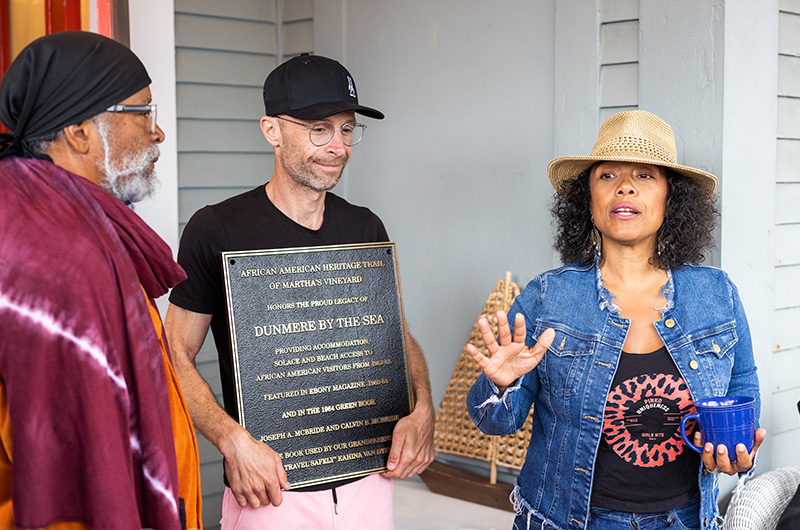
Kahina Van Dyke and her husband Claudio Casarotti bought Dunmere in 2020 from the Haney family. The couple also owns the Narragansett House and Isabelle’s Beach House in Oak Bluffs. Ms Van Dyke and Mr. Casarotti were joined by their children, Oscar and Bella, as well as Leon Van Dyke, Ms. Van Dyke’s father, an 88-year-old civil rights activist.
“This is a great day and we must never, never forget that we are a great people,” Mr. Van Dyke said.
When the cottage was up for sale, Ms. Van Dyke said she wrote a letter to the Haney family. In the letter she did not lobby the family to sell to her; she asked that they sell to someone who would honor the legacy of the cottage.
“I wrote the letter to the sellers . . . to convince them to sell it to somebody who cares about this community,” she said.
Ms. Van Dyke thanked the McBride brothers, who have since died but whose presence loomed over the ceremony.
“They bought this place, these African American brothers from Harlem, and they immediately made sure that everyone knew it was here,” Ms. Van Dyke said. “They made it clear that African Americans were welcome here and they were by the sea. There was a beach you could access and that wasn’t common.”
As the current owner of the cottage, Ms. Van Dyke said she has made a point to continue the tradition of inclusivity.
“Everyone is welcome on this porch. Everyone is welcome in our garden and everyone is welcome in our hearts,” she said.
That evening, attention turned to food with Taste of Juneteenth, the final event of the weekend, presented by the Martha’s Vineyard branch of the NAACP.
The event took place at the Portuguese-American Club in Oak Bluffs, where people gathered to mingle at the picnic tables beneath the red and blue Juneteenth flag.
NAACP branch president Arthur Hardy-Doubleday opened the festivities.
“The NAACP Martha’s Vineyard branch feels completely flattered that you are spending Father’s Day and the first federally recognized Juneteenth here with us tonight,” he said.
Dr. Lorna Andrade gave the opening prayer, then turned the mic back to Mr. Hardy-Doubleday to recognize the many volunteers who made the event possible. He singled out NAACP member Russ Ashton, along with “all the amazing chefs who have shown up and donated this food.”
Retired Oak Bluffs police chief and former NAACP president Erik Blake was also presented with a special award. Then Toni Kauffman from the Juneteenth planning committee set off the starting pistol.
“Chefs, are you ready?” she asked, and then addressed the attendees. “Go enjoy the delicious food!”
Mr. Doubleday echoed her directive: “Go eat!”
The hungry crowd was happy to oblige, sampling peppery shrimp and cheese grits from chef Amy Johnson, along with coconut shrimp with sweet (and slightly spicy) chili sauce and cornbread from Chef Ralston at Flavors MV.
Chef Deon Thomas doubled down on the spice with his jerk chicken, among the most anticipated meals that evening.
Winston’s Kitchen workers hurriedly assembled chicken tacos, topping each off with a mango salsa, and chef Canieka Fleming had perhaps the most original offering, an open-faced finger sandwich of red velvet cornbread, braised short ribs, collard greens and crispy onions. It was only two bites, but packed enough flavor for an entire meal.
Chef Anthony Foster finished things off with sweet BBQ ribs, rich, hearty,and smoky, and Juli Vanderhoop from Orange Peel Bakery supplied dessert, centered on her honey drizzled biscuits.
It was a fulfilling evening, and no one went home hungry.
The same could be said of the whole weekend of Juneteenth events on the Island.
Thomas Humphrey and Diego Lasarte contributed reporting.

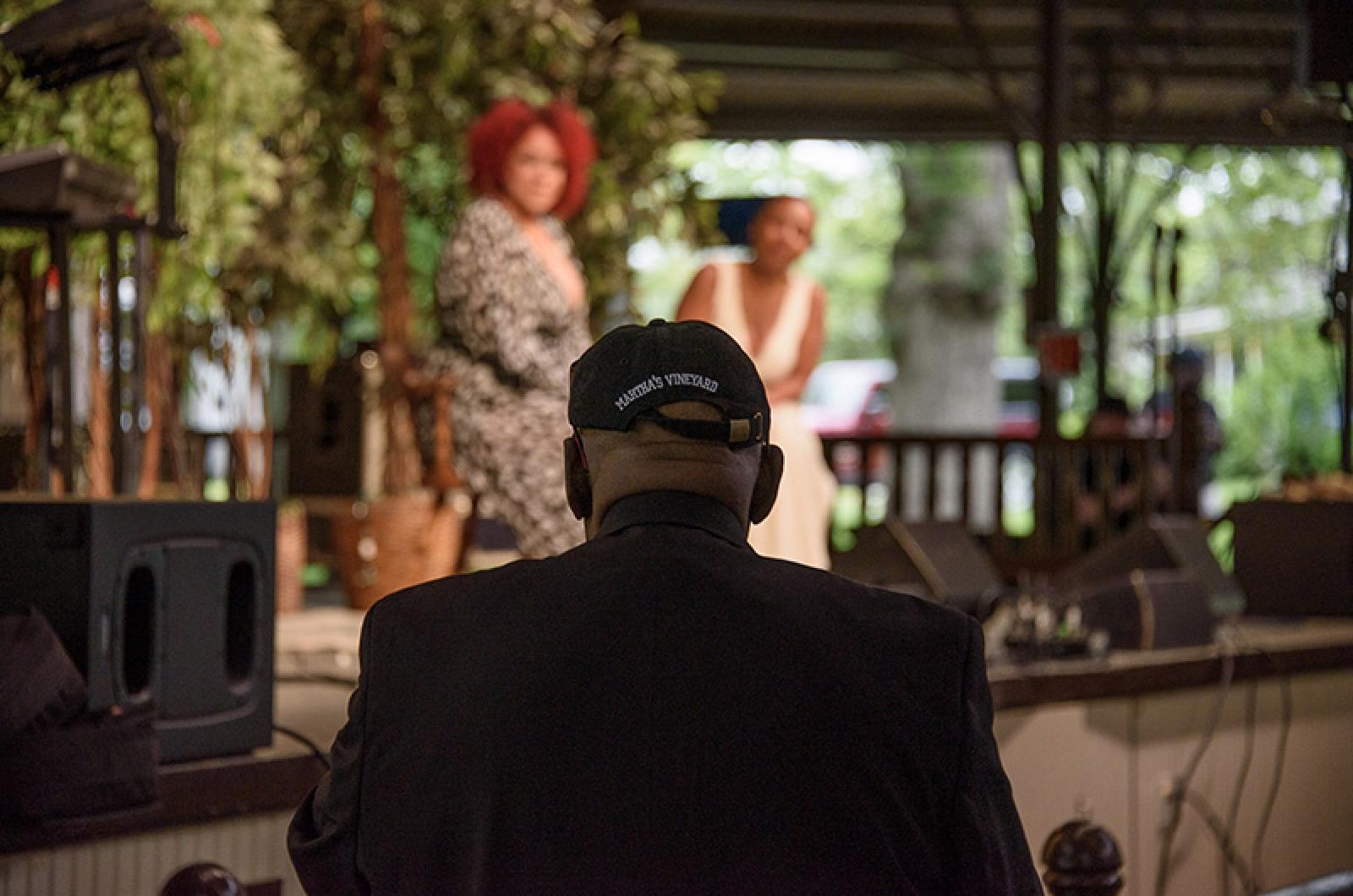
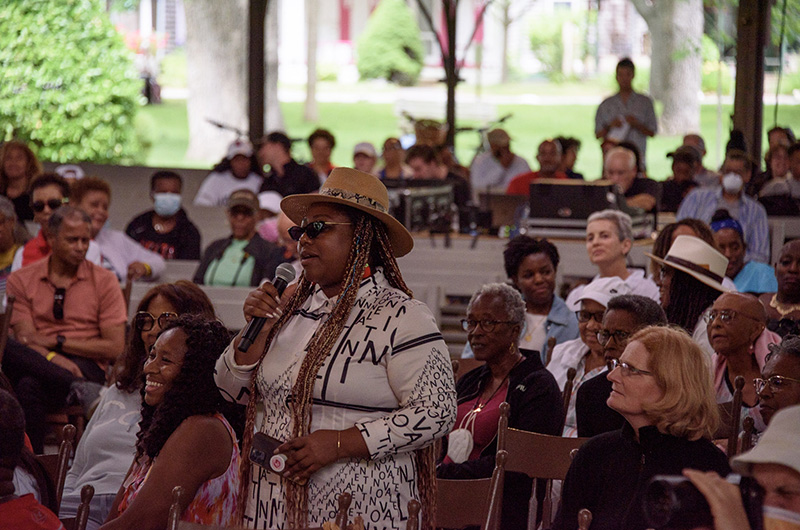
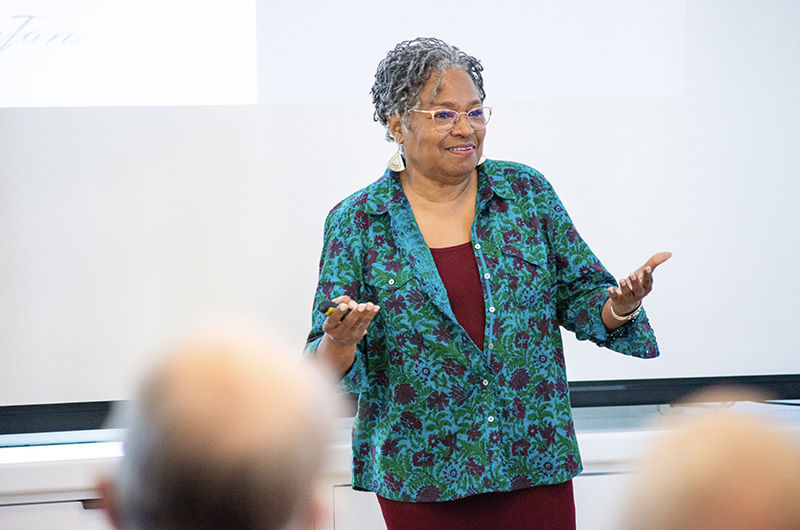
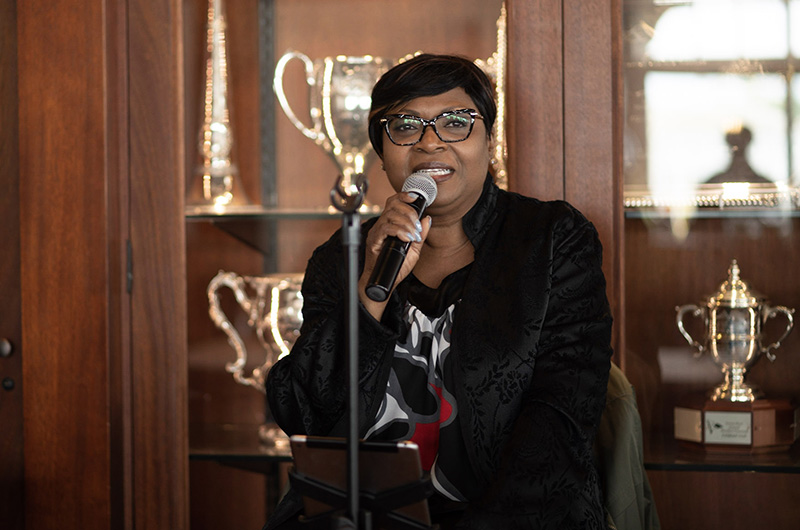






Comments (5)
Comments
Comment policy »